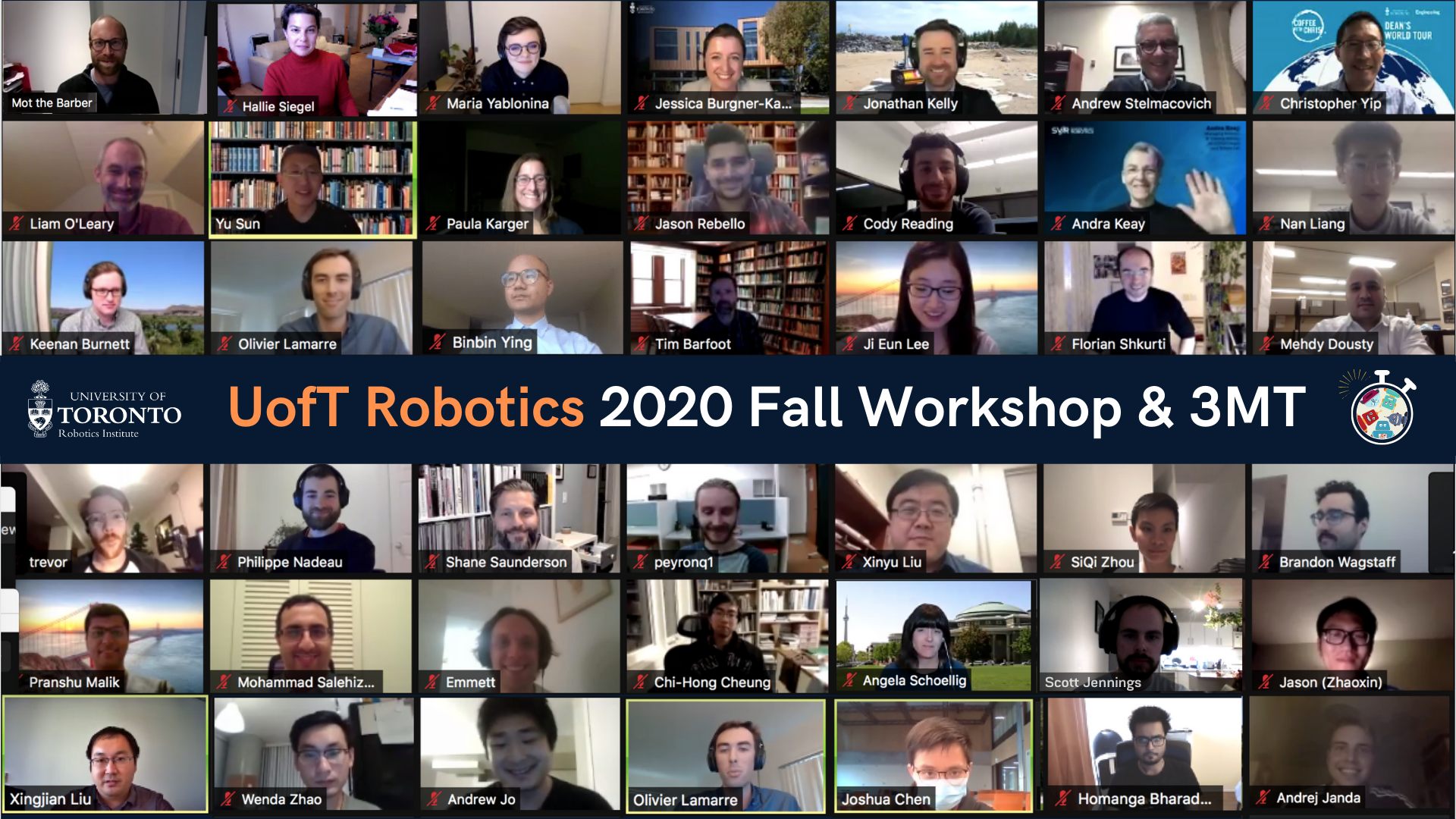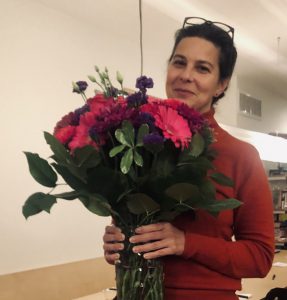
November 12 was a great day for robotics at UofT! The pandemic put a new twist on our fall student workshop, but we made the most of it.
The workshop was co-chaired by Outreach Committee members Jessica Burgner-Kahrs, Jonathan Kelly, and Hallie Siegel. The team decided to change up the format to keep pace with our new pandemic reality, holding our first ever Three-Minute Thesis (3MT) competition, and featuring an invited keynote by UofT’s newest robotics faculty member, Maria Yablonina from the Daniels Faculty of Architecture. We had 90 participants attending, with presentations from 13 labs, 7 departments and 3 campuses — a remarkable showing of robotics breadth and depth packed into just 3 hours.
FASE Dean Chris Yip joined us via video uplink from his online world tour to deliver a brief message on the value of science communication and why it’s important to be able to speak to non-experts about your research.
The 3MT competition got us started at a quick pace as robotics grad students made a go of compressing years of research into just three minutes. While the typical 3MT competition allows only one static slide, we decided to change up the rules and allow 3 slides and video/animation too. Robots move in the real world and that’s what’s impactful about them – showing movement is part of telling that story.
Judges Andrew Stelmacovich (Executive Director of Advancement at UTM), and Tyler Irving (Senior Communications Officer at UofT Engineering) are experts in their own right and know how to pitch science to a donor or to the news media, but are not technical experts in the field of robotics. Fellow judge Andra Keay (Managing Director Silicon Valley Robotics) is undoubtedly a robot aficionado but her expertise in accelerators and the VC world gives her a discerning eye for pitches. In short, students had to elevate their dialogue to connect and stand out against 17 other competitors. Our judges reminded us this is not so unlike the real world where decision-makers have to make funding or hiring decisions based on first impressions. Learning how to connect, and to connect quickly, is at the heart of any memorable pitch.
Our expert panel of judges had to work fast to keep up, but MCs Jessica Burgner-Kahrs and Jonathan Kelly filled the minutes between presentations with banter and robot jokes. After two heats of presentations, Maria Yablonina gave an outstanding keynote on her work with mobile robotic fabrication, detailing the intricacies of setting up multiple wall mounted robots and coordinating their movements.
After the keynote, the audience voted for the People’s Choice Award. It proved difficult for the audience to declare a winner in this highly competitive field, but in the end SiQi Zhou from Angela Schoellig’s Dynamic Systems Lab won the People’s Choice for her presentation on Neural Nets for Robot Control. SiQi illustrated the value of neural nets using real-world examples of robots doing grocery delivery, disinfection, and drone performance. “It was a challenge to speak in public,” said Zhou, “but I was glad that I tried.” Before the competition, Zhou received advice from her supervisor and labmates to make simple visuals to support her oral explanation. “This allowed me to think about how to condense my research as a coherent story and present it in a way that is understandable by audiences who are not in my research area.”
Then came the Judges’ award winners. Judges stressed that, when selecting a winner, they were looking for the human element and the ability to connect with an audience through story.
The Runner Up was Nan Liang, a PhD student from Jessica Burgner-Kahrs‘ Continuum Robotics Lab who understands how to make that personal connection. Nan started with the startling statistic that 27 Canadians are diagnosed with a brain tumor every day, and explained how a surgical robot that is flexible and as small as a needle is safer and less invasive than current alternatives. What was Liang’s winning approach? “I use minimal text on the slides,” said Liang. “This helped to keep the audience following my speech. In terms of preparation, it also helps to practise as much as possible.”
First Place went to Jason Rebello, from Steve Waslander’s TRAIL Lab, for his presentation on Enhancing the Vision of Autonomous Robots.The magic came in how Jason took us from “senses” to “sensors”, helping our judges understand the key challenges in machine vision and perception in relation to the very human act of appreciating a slice of chocolate cake! Jason compared the sensors on a vehicle to the five human senses, and stressed the importance of humans being able to trust self-driving vehicles … Ultimately this framed for both how calibrated dynamic camera clusters can help robots perform more reliably and safely, and why it matters. “One does not need fancy technical ideas to get people interested in your research,” said Rebello. “It is more about the relatable and emotional aspects of your presentation that connect with the audience and helps get them intrigued.”
You can find clips of many of the presentations on our YouTube 3MT playlist.

“As co-chairs we had a great deal of fun organizing this event together,” said Siegel. “It was gratifying to see our efforts and our community come together in this way. And an especially nice surprise to have thank you flowers from my co-chairs arrive at my door literally 10 minutes before the event began! The day was a reminder that we can still be a community even when we can’t all be in the same place together. Thank you Jessica and Jonathan!”
While we surely missed seeing everyone in person this year, we enjoyed the day nonetheless. Thanks to our judges, coaches, competitors, keynote and all our participants for making our fall workshop a success!
We are already looking forward to next year.
